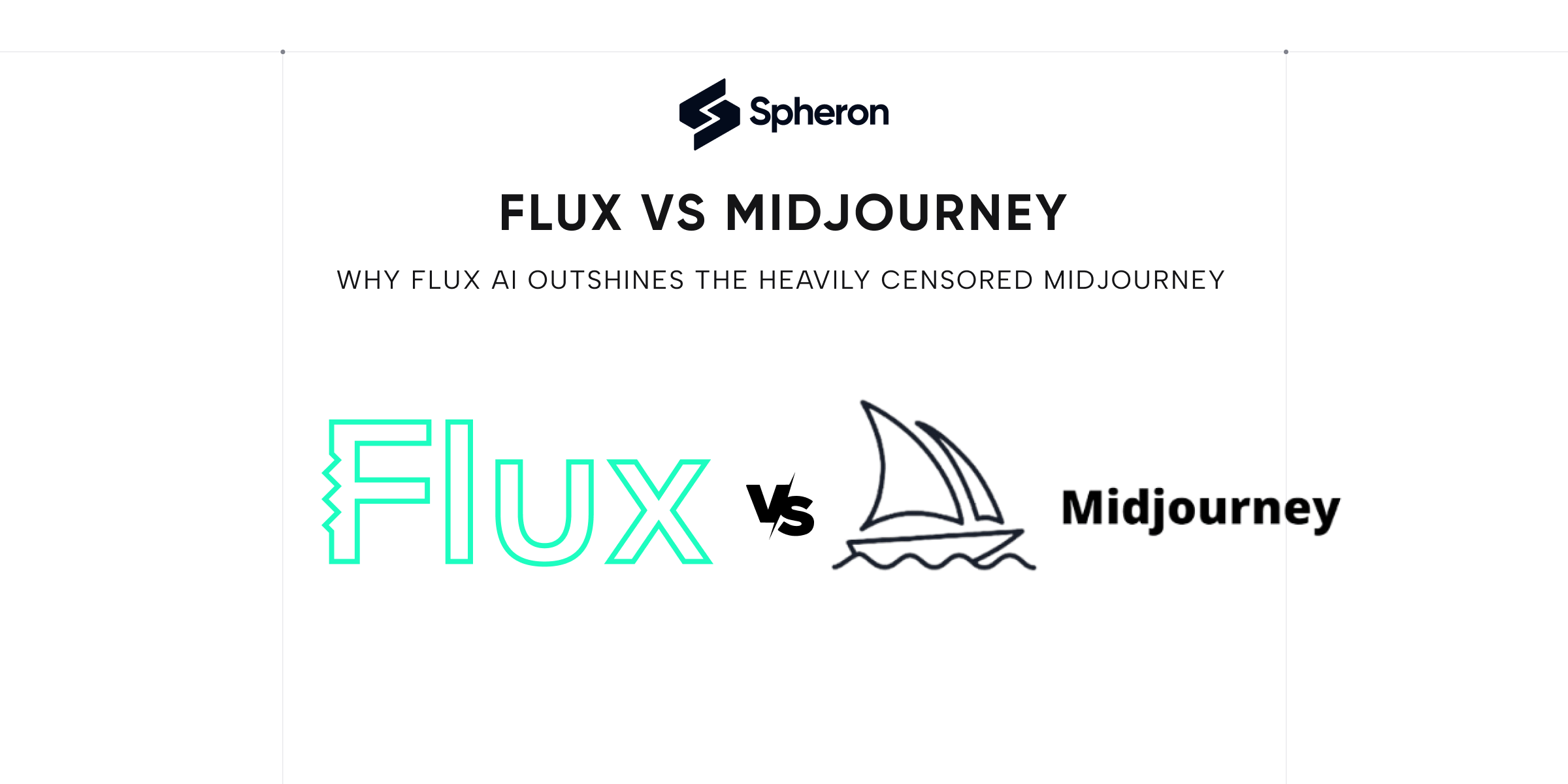Why Flux AI Outshines the Heavily Censored MidJourney
 Spheron Network
Spheron NetworkTable of contents
- 1. Overview: What Are Flux AI and MidJourney?
- 2. Breaking Down Flux AI’s Core Models
- 3. MidJourney: A Closer Look at Its Strengths
- 4. Prompt Showdown: Flux AI vs MidJourney
- 5. Censorship: Creative Freedom vs Restrictions
- 6. Pricing: Which Platform Offers Better Value?
- 7. Why Artistic Freedom Matters
- 8. Cultural Impact: Censorship and Expression
- 9. Conclusion: Is Flux AI Better Than MidJourney?
- FAQs

In today's world, where technology blends with creativity, AI-powered art generators are becoming the go-to playground for artists, designers, and hobbyists. However, a heated debate around censorship and artistic freedom is emerging, especially on popular platforms like MidJourney.
If you've ever encountered the frustrating "Oops, that content is too spicy" message on MidJourney, you're not alone. But now, there is a new player in town—Flux AI, an open-source alternative that promises a censorship-free experience. So, the big question is: is Flux better?
We're about to dive deep into this battle and compare Flux with MidJourney, looking at their approach to prompts, creativity, censorship, and pricing. This comparison will explore both platforms' emotional, artistic, and societal dimensions to determine which one truly takes the crown. Ready? Let's dive in!
1. Overview: What Are Flux AI and MidJourney?
Let’s start by introducing the contenders.
Flux AI is like that rebellious friend who breaks all the rules. Developed by ex-Stability AI members under the name Black Forest Labs, Flux is open-source, allowing full creative freedom. You can generate anything from peaceful nature scenes to intense sci-fi battles without any restrictions. It's the no-limits playground for artistic expression.
On the other hand, MidJourney is a polished, well-established platform known for its stunningly beautiful images. However, it imposes strict content guidelines. Images depicting violence, explicit content, or even political themes are strictly forbidden, leaving artists feeling somewhat boxed in.
2. Breaking Down Flux AI’s Core Models
Flux AI offers three primary models, each designed for different user needs:
Schnell: Fast and lightweight, best for quick image generation with minimal hardware requirements.
Dev: A mid-tier option offering more refined results without top-end polish.
Pro: Flux’s premium model delivers top-quality images, prompt adherence, and maximum versatility.
If you choose to run Flux on your hardware, be prepared to invest in powerful GPUs and plenty of RAM. DigitalOcean recommends at least 40 GB VRAM machines at the minimum. It's a demanding tool, but the rewards are worth it for those seeking creative control.
3. MidJourney: A Closer Look at Its Strengths
MidJourney recently upgraded to its v6.1 algorithm, which improved aspects like hand coherence, facial accuracy, and detailed features. This upgrade reduced the common "weird hand" problem that plagued earlier AI art. However, the platform’s strict censorship remains a major drawback, limiting the types of content you can create.

What’s new in V6.1?
More coherent images (arms, legs, hands, bodies, plants, animals, etc.)
Much better image quality (reduced pixel artifacts, enhanced textures, skin, etc.)
More precise, detailed, and correct small image features (eyes, small faces, far away hands, etc.)
New 2x upscale with much better image/texture quality
Roughly 25% faster for standard image jobs
Improved text accuracy (when drawing words via “quotations” in prompts)
A new personalization model with improved nuance, surprise, and accuracy
Personalization code versioning (use any personalization code from old jobs to use the personalization model and data from that job)
A new
--q 2mode, which takes 25% longer to (sometimes) add more texture at the cost of reduced image coherenceThings should look “generally more beautiful” across the board
4. Prompt Showdown: Flux AI vs MidJourney
Now, let’s compare how these platforms handle the same prompt. Imagine you enter the prompt: “Three knights stand on a red carpet. The knight on the left holds a banner that says ‘Creativity,’ the middle one holds a banner that says ‘With,’ and the right knight holds one that says ‘AI.’ In the background, a golden phoenix rises.”
On MidJourney, the images look aesthetically pleasing, but the banners might be jumbled or unclear. The phoenix appears as an oddly shaped bird instead of a majestic creature. While the visuals are lovely, the specifics often miss the mark.
Flux AI, however, tends to nail it. The knights hold clear banners, and the phoenix appears as a distinct, powerful figure in the background. Flux wins the prompt battle with its ability to interpret and render the scene accurately.
5. Censorship: Creative Freedom vs Restrictions
This is where the two platforms sharply diverge. MidJourney enforces strict content moderation—blocking anything remotely controversial, whether it’s violent, explicit, or politically charged. This can feel stifling, especially for creators who want to push the boundaries of their work.
In contrast, Flux AI embraces a “no censorship” policy. Artists have full freedom to create anything, whether light-hearted or provocative. This isn’t just about creating shocking imagery—Flux allows artists to explore complex themes and bold social commentary without restrictions.
6. Pricing: Which Platform Offers Better Value?
Regarding pricing, the difference between MidJourney and Flux is significant.
MidJourney starts at $10 monthly for 200 images, with a $30 monthly option for unlimited generation (with limited fast-generation hours).
Flux AI is free if you run it on your own hardware, or it can be purchased on third-party platforms like Hugging Face for around $1 per 333 images.
Flux offers a better deal for budget-conscious users. However, MidJourney’s subscription model is more convenient for those who want a plug-and-play solution without worrying about hardware requirements.
7. Why Artistic Freedom Matters
The censorship debate extends beyond creating art. When platforms like MidJourney limit what artists can generate, it raises questions about creative freedom. Art has historically been a form of expression, often exploring sensitive or controversial subjects. By enforcing restrictive guidelines, platforms risk curbing that natural, essential creativity.
By remaining open-source and uncensored, Flux taps into the desire for uninhibited exploration. Artists can address difficult topics, create provocative pieces, or simply experiment with unique ideas.
8. Cultural Impact: Censorship and Expression
In a time when social media platforms and tech companies dictate what we can or can’t say, Flux represents a pushback against that control. The growing demand for open platforms reflects a broader cultural movement advocating for freedom of speech and artistic expression.
Choosing between Flux and MidJourney is, in many ways, a choice about what kind of world we want to foster—a world where creativity is guided and sanitized or it’s allowed to flourish without boundaries.
9. Conclusion: Is Flux AI Better Than MidJourney?
MidJourney undoubtedly excels at generating stunning visuals, often producing some of the best-looking AI art. However, its censorship policies make it less appealing for those who want complete freedom to explore any creative concept.
Though less polished in some respects, Flux AI offers an uncensored experience that allows true artistic expression. For creators who value freedom over aesthetics, Flux is the clear winner.
Ultimately, the best platform for you depends on your priorities. If you want convenience and polished images, stick with MidJourney. But if you’re looking to push creative boundaries without restrictions, you should consider Flux.
FAQs
1. Can I use both Flux AI and MidJourney?
Yes, many artists use both platforms depending on the type of project they’re working on. MidJourney for refined, polished images, and Flux for unrestricted creativity.
2. What kind of hardware do I need to run Flux AI?
If you plan on running Flux locally, you'll need a powerful GPU and significant RAM. Otherwise, you can use third-party platforms like Hugging Face to avoid hardware costs.
3. Does MidJourney allow any form of controversial content?
MidJourney has strict rules against violence, nudity, and politically charged content, limiting what you can create in those areas.
4. How does Flux AI handle NSFW content?
Flux does not censor content, allowing NSFW and other controversial themes without moderation.
5. Is there a free version of MidJourney?
MidJourney offers limited free trials, but a paid subscription is required for regular use.
Subscribe to my newsletter
Read articles from Spheron Network directly inside your inbox. Subscribe to the newsletter, and don't miss out.
Written by

Spheron Network
Spheron Network
On-demand DePIN for GPU Compute